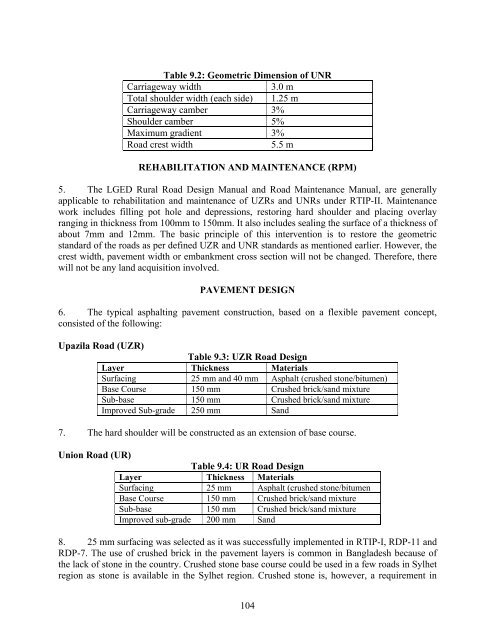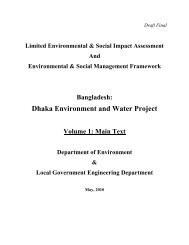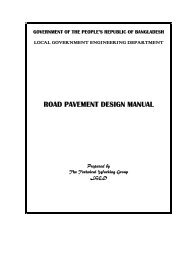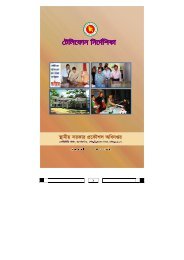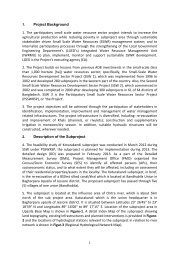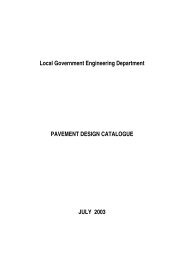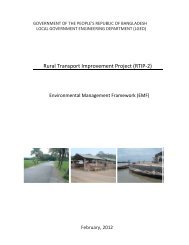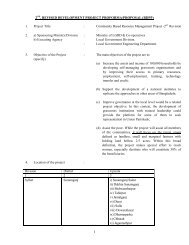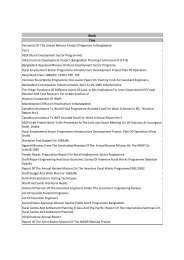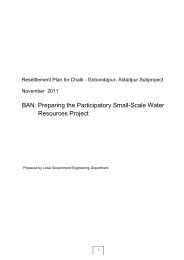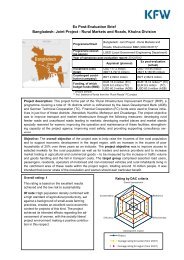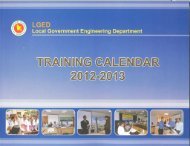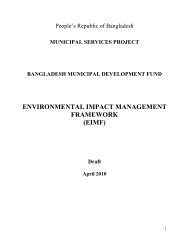PAD - LGED
PAD - LGED
PAD - LGED
Create successful ePaper yourself
Turn your PDF publications into a flip-book with our unique Google optimized e-Paper software.
Table 9.2: Geometric Dimension of UNR<br />
Carriageway width<br />
3.0 m<br />
Total shoulder width (each side) 1.25 m<br />
Carriageway camber 3%<br />
Shoulder camber 5%<br />
Maximum gradient 3%<br />
Road crest width<br />
5.5 m<br />
REHABILITATION AND MAINTENANCE (RPM)<br />
5. The <strong>LGED</strong> Rural Road Design Manual and Road Maintenance Manual, are generally<br />
applicable to rehabilitation and maintenance of UZRs and UNRs under RTIP-II. Maintenance<br />
work includes filling pot hole and depressions, restoring hard shoulder and placing overlay<br />
ranging in thickness from 100mm to 150mm. It also includes sealing the surface of a thickness of<br />
about 7mm and 12mm. The basic principle of this intervention is to restore the geometric<br />
standard of the roads as per defined UZR and UNR standards as mentioned earlier. However, the<br />
crest width, pavement width or embankment cross section will not be changed. Therefore, there<br />
will not be any land acquisition involved.<br />
PAVEMENT DESIGN<br />
6. The typical asphalting pavement construction, based on a flexible pavement concept,<br />
consisted of the following:<br />
Upazila Road (UZR)<br />
Table 9.3: UZR Road Design<br />
Layer Thickness Materials<br />
Surfacing 25 mm and 40 mm Asphalt (crushed stone/bitumen)<br />
Base Course 150 mm Crushed brick/sand mixture<br />
Sub-base 150 mm Crushed brick/sand mixture<br />
Improved Sub-grade 250 mm Sand<br />
7. The hard shoulder will be constructed as an extension of base course.<br />
Union Road (UR)<br />
Table 9.4: UR Road Design<br />
Layer Thickness Materials<br />
Surfacing 25 mm Asphalt (crushed stone/bitumen<br />
Base Course 150 mm Crushed brick/sand mixture<br />
Sub-base 150 mm Crushed brick/sand mixture<br />
Improved sub-grade 200 mm Sand<br />
8. 25 mm surfacing was selected as it was successfully implemented in RTIP-I, RDP-11 and<br />
RDP-7. The use of crushed brick in the pavement layers is common in Bangladesh because of<br />
the lack of stone in the country. Crushed stone base course could be used in a few roads in Sylhet<br />
region as stone is available in the Sylhet region. Crushed stone is, however, a requirement in<br />
104


